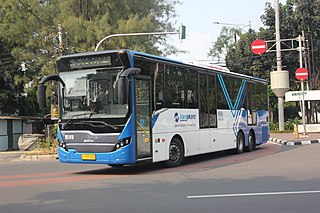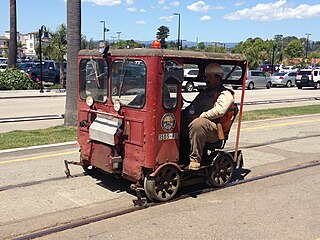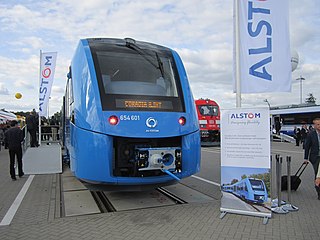
A trolleybus is an electric bus that draws power from dual overhead wires using spring-loaded trolley poles. Two wires, and two trolley poles, are required to complete the electrical circuit. This differs from a tram or streetcar, which normally uses the track as the return path, needing only one wire and one pole. They are also distinct from other kinds of electric buses, which usually rely on batteries. Power is most commonly supplied as 600-volt direct current, but there are exceptions.

The Kamkorp Group was a privately held holding company, encompassing a wide range of businesses but operates mainly as Frazer-Nash Research Ltd. It was owned by UK-based Indian businessman Kamal Siddiqi. Over the past 25 years, the Kamkorp Group has developed proprietary digital electric and hybrid electric powertrains and products for the transportation and industrial markets. The company has produced various automobile prototypes under the brands Frazer-Nash and Metrocab. Until 2020 it owned Bristol Cars, under which brand the Bristol Bullet sports car was being developed. The Bullet was unveiled on 26 July 2016 and production was to have started in 2017.

A railcar is a self-propelled railway vehicle designed to transport passengers. The term "railcar" is usually used in reference to a train consisting of a single coach, with a driver's cab at one or both ends. Some railway companies, such as the Great Western, termed such vehicles "railmotors".

An electric vehicle (EV) is a vehicle that uses one or more electric motors for propulsion. It can be powered by a collector system, with electricity from extravehicular sources, or it can be powered autonomously by a battery. EVs include, but are not limited to, road and rail vehicles, surface and underwater vessels, electric aircraft, and electric spacecraft. For road vehicles, together with other emerging automotive technologies such as autonomous driving, connected vehicles, and shared mobility, EVs form a future mobility vision called Connected, Autonomous, Shared, and Electric (CASE) Mobility.

Bus rapid transit (BRT), also referred to as a busway or transitway, is a bus-based public transport system designed to have much more capacity, reliability and other quality features than a conventional bus system. Typically, a BRT system includes roadways that are dedicated to buses, and gives priority to buses at intersections where buses may interact with other traffic; alongside design features to reduce delays caused by passengers boarding or leaving buses, or paying fares. BRT aims to combine the capacity and speed of a light rail or metro system (LRT) or heavy rail with the flexibility, lower cost and simplicity of a bus system.
The California Air Resources Board is an agency of the government of California that aims to reduce air pollution. Established in 1967 when then-governor Ronald Reagan signed the Mulford-Carrell Act, combining the Bureau of Air Sanitation and the Motor Vehicle Pollution Control Board, CARB is a department within the cabinet-level California Environmental Protection Agency.

A zero-emission vehicle, or ZEV, is a vehicle that does not emit exhaust gas or other pollutants from the onboard source of power. The California definition also adds that this includes under any and all possible operational modes and conditions. This is because under cold-start conditions for example, internal combustion engines tend to produce the maximum amount of pollutants. In a number of countries and states, transport is cited as the main source of greenhouse gases (GHG) and other pollutants. The desire to reduce this is thus politically strong.

A speeder is a small railcar formerly used around the world by track inspectors and work crews to move quickly to and from work sites. Although slow compared to a train or car, it is called speeder because it is faster than a human-powered vehicle such as a handcar. Motorised inspection cars date back to at least 1896, when it was reported that the U.S. Daimler Motor Company created a gasoline-powered rail inspection car capable of 15 mph (24 km/h).

A fuel cell vehicle (FCV) or fuel cell electric vehicle (FCEV) is an electric vehicle that uses a fuel cell, sometimes in combination with a small battery or supercapacitor, to power its onboard electric motor. Fuel cells in vehicles generate electricity generally using oxygen from the air and compressed hydrogen. Most fuel cell vehicles are classified as zero-emissions vehicles that emit only water and heat. As compared with internal combustion vehicles, hydrogen vehicles centralize pollutants at the site of the hydrogen production, where hydrogen is typically derived from reformed natural gas. Transporting and storing hydrogen may also create pollutants. Fuel cells have been used in various kinds of vehicles including forklifts, especially in indoor applications where their clean emissions are important to air quality, and in space applications. Fuel cells are being developed and tested in trucks, buses, boats, ships, motorcycles and bicycles, among other kinds of vehicles.

A green vehicle, clean vehicle, eco-friendly vehicle or environmentally friendly vehicle is a road motor vehicle that produces less harmful impacts to the environment than comparable conventional internal combustion engine vehicles running on gasoline or diesel, or one that uses certain alternative fuels. Presently, in some countries the term is used for any vehicle complying or surpassing the more stringent European emission standards, or California's zero-emissions vehicle standards, or the low-carbon fuel standards enacted in several countries.
Zero emission refers to an engine, motor, process, or other energy source, that emits no waste products that pollute the environment or disrupt the climate.

Rail inspection is the practice of examining rail tracks for flaws that could lead to catastrophic failures. According to the United States Federal Railroad Administration Office of Safety Analysis, track defects are the second leading cause of accidents on railways in the United States. The leading cause of railway accidents is attributed to human error. The contribution of poor management decisions to rail accidents caused by infrequent or inadequate rail inspection is significant but not reported by the FRA, only the NTSB. Every year, North American railroads spend millions of dollars to inspect the rails for internal and external flaws. Nondestructive testing (NDT) methods are used as preventive measures against track failures and possible derailment.
Stevens Vehicles Ltd is a British electric car and van manufacturer based in Port Talbot. The company is a manufacturer of zero emission electric cars and vans designed by the father and son team of Tony Stevens and Peter Stevens. The vehicles were conceived, designed and developed in Kent, England and are manufactured at Port Talbot, Wales.

A battery electric vehicle (BEV), pure electric vehicle, only-electric vehicle, fully electric vehicle or all-electric vehicle is a type of electric vehicle (EV) that exclusively uses chemical energy stored in rechargeable battery packs, with no secondary source of propulsion. BEVs use electric motors and motor controllers instead of internal combustion engines (ICEs) for propulsion. They derive all power from battery packs and thus have no internal combustion engine, fuel cell, or fuel tank. BEVs include – but are not limited to – motorcycles, bicycles, scooters, skateboards, railcars, watercraft, forklifts, buses, trucks, and cars.

In transportation, hydrail is the generic term describing all forms of rail vehicles, large or small, which use on-board hydrogen fuel as a source of energy to power the traction motors, or the auxiliaries, or both. Hydrail vehicles use the chemical energy of hydrogen for propulsion, either by burning hydrogen in a hydrogen internal combustion engine, or by reacting hydrogen with oxygen in a fuel cell to run electric motors. Widespread use of hydrogen for fueling rail transportation is a basic element of the proposed hydrogen economy. The term has been used by research scholars and technicians around the world.

The AgustaWestland Project Zero is a hybrid tiltrotor/Lift fan aircraft. It has been developed by AgustaWestland as a technology demonstrator, and is used to investigate all-electric propulsion and other advanced technologies. It is the world's first electric tiltrotor aircraft.

An electric road, eroad, or electric road system (ERS) is a road which supplies electric power to vehicles travelling on it. Common implementations are overhead power lines above the road and ground-level power supply through conductive rails or inductive coils embedded in the road. Overhead power lines are limited to commercial vehicles while ground-level power can be used by any vehicle, which allows for public charging through power metering and billing systems. Of the three systems, ground-level conductive rails are estimated to be the most cost-effective. Korea was the first to implement an induction-based public electric road with a commercial bus line in 2013 after testing an experimental shuttle service in 2009. Sweden has been performing assessments of various electric road technologies since 2013 and expects to start formulating a national electric road system in 2022 and finish planning by 2033.
The Swedish Transport Administration electric road program or Swedish Transport Administration Electrification Program is a program involving the assessment, planning, and implementation of an electric road national infrastructure for Sweden by Trafikverket, the Swedish Transport Administration.

The Innovative Clean Transit Rule (ICT) is a regulation promulgated by the California Air Resources Board which requires public transit agencies in the state of California to shift their bus fleets to zero emissions buses (ZEB), either electric buses or fuel cell buses. By 2029, only ZEBs will be allowed for new bus purchases, and the entire fleet must use ZEBs by 2040.
As of March 2021, there were about 4,000 electric vehicles in Delaware. As of May 2023, there were just 142 charging locations located in Delaware, putting Delaware in the bottom 10 states for charging stations in the US. According to official sources only 11 new charging stations have been added in the past two years. Information for Delaware's laws and incentives for electric vehicles can be found at the United States Department of Energy's Alternative Fuel Data Center.















